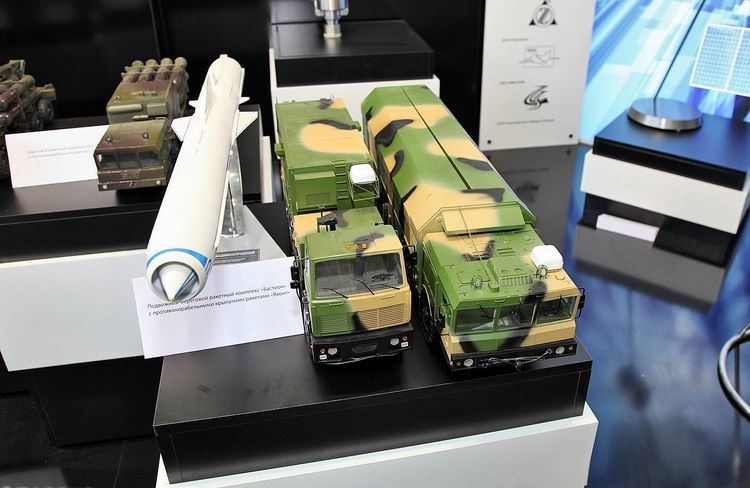Produced 2010 | In service 2015-present Manufacturer NPO Mashinostroenia | |
 | ||
Type Mobile anti-ship missile system | ||
The K-300P Bastion-P (NATO reporting name SS-C-5 Stooge) is a Russian mobile coastal defence missile system. The system was developed together with the Belarus company Tekhnosoyuzproekt.
Contents
Design
The main role of the Bastion-P is to engage surface ships including carrier battle groups, convoys, and landing craft. A typical battery is composed of 1-2 command and control vehicles based on the Kamaz 43101 6×6 truck, one support vehicle, four launcher vehicles based on the MZKT-7930 8×8 chassis each operated by a 3-man crew and holding two missiles, and four loader vehicles; launcher vehicles can be located up to 25 km (16 mi) away from the C2 vehicles. Upon halting, missiles can be readied for firing within five minutes, and both fired in 2-5 second intervals. The mobile launcher can remain on active standby over a period of 3–5 days, or up to 30 days when accompanied by a combat duty support vehicle.
The missile used by the Bastion-P is the P-800 Oniks, a supersonic anti-ship missile with a 200–250 kg (440–550 lb) warhead. They are fired vertically from the launchers using a solid-fuel rocket booster for initial acceleration, then use a liquid-fuel ramjet for sustained cruising at Mach 2.5. The Oniks/Yakhont's maximum range varies at 120–300 km (75–186 mi; 65–162 nmi) utilizing a low-low or hi-low flight trajectory respectively. Using satellite guidance at the initial flight stage and active radar guidance when approaching a target, the missile can fly to an altitude of 14,000 m (46,000 ft) before descending to sea-skimming altitude of 5 m at the final stage, useful up to sea state 7.
Operational history
On 2 March 2011, it was reported that Russia would be deploying the system on the Kuril Islands in the Far East. The deployment was finally conducted in 2016.
On 15 March 2015, it was reported that Russia had deployed the system on the Crimea. Silo-based missile complex should be deployed on Object 100 by 2020.
On 15 November 2016, Russia announced it had deployed K-300P Bastion-P systems to Syria, where it fired Oniks missiles at land targets as part of the Russian military intervention in Syria, demonstrating a previously undisclosed land attack capability for the coastal defense system; the P-800 uses a combination of autopilot, INS, and a radio altimeter for mid-course guidance and a monopulse dual-mode active/passive seeker for terminal guidance. Modified software in the Bastion's guidance system enables the missiles to dive onto stationary land targets, striking preprogrammed coordinates.
